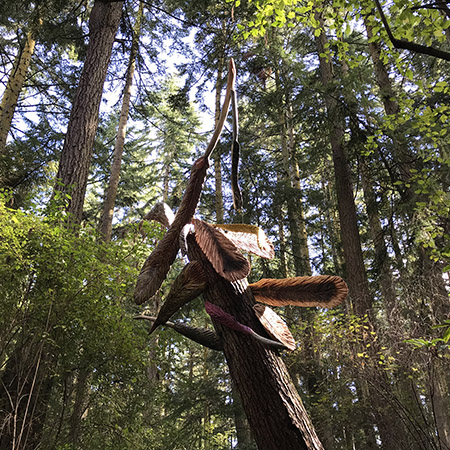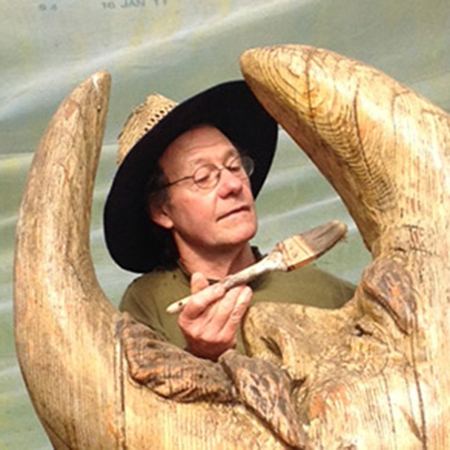SUMMARY
Pat McVay is from Whidbey Island and has been crafting wood for over 40 years. Currently, most of his work is large-scale carving from already-down trees, using everything from a chainsaw to fine chisels. His whimsical and unusual sense is often the basis for unique carvings of people and animals. Many of Patʼs creations are visible in public spaces up and down the West Coast. “Icarus Was Here” tells a cautionary tale from ancient Greece that still resonates today as a warning of danger, how to stay safe, and the consequences of not listening to wise advice. You may recall the ancient story of how Icarus escaped from being imprisoned in a tower by making wings from bird feathers and candle wax. However, he ignored his father’s advice, flew too close to the sun, the wax of the wings melted, and he plummeted to earth. The feathers here are carved from already-fallen cedar trees and painted, with some torched for highlights and others varnished with mica to sparkle in sunlight.
ICARUS WAS HERE
PAT MCVAY
ABOUT THE SCULPTURE
The story of Icarus is a cautionary tale from ancient Greece that still resonates today, especially now. It is a warning of danger, how to stay safe, and the consequences of not listening to wise advice. Icarus and his family were imprisoned unjustly on an island, far from shore. They were locked in a high tower with no way to escape. His father, a great and clever craftsman, created pairs of wings made from bird feathers found on the tower. The feathers were held together with bee’s wax melted from candles. When the wings were ready, Icarus was cautioned not to fly too low, or the sea mist could make his wings too heavy, and not to fly too high, or the sun would melt the soft wax holding the feathers. Then they jumped from the tower and soared to their escape! Icarus soon became so excited with flying that he forgot the warning, soaring ever higher. The hot sun melted the wax and many feathers fell out. Sadly, he fell into the sea and drowned. From this ancient story, Pat envisioned multiple colorful feathers fluttering to earth in different directions. He was intrigued by the leaning snag tree in the Sculpture Forest and figured out how to use it for this site installation. Separately, this is also a logic puzzle for you (answer in the next paragraph, so do not read ahead yet): Why was the tree cut at that point higher up on the tree? Why would someone have used a chainsaw there instead of at a normal point close to the ground…? Look around the tree and see if you can figure it out. Answer: The entire tree had fallen over to the ground. The tree was cut in large sections that you see along the trail to your left. When the lowest section of the tree was cut, the weight of the soil and roots in the rootball on the right were greater than the weight of the cut tree trunk. The heavy rootball flung the tree trunk back up into the air, resting in its current slightly angled position (and then waiting for Pat).ABOUT THE SCULPTOR
Patʼs history in the arts goes back 40 years to Paris, where he began his career by repairing and making furniture. Pat had a small shop, a few tools and lots of paint used to hide mistakes. People began asking him to create new furniture. Then came work in porcelain tile. After moving to the Olympic Peninsula, his attraction to the natural forms of the forest led him into wood carving.
Currently, most of his work is large-scale carvings from already-down trees, using everything from a chainsaw to fine chisels. His whimsical and even comical sense is often the basis of unique carvings of people and animals. Many of Patʼs works are visible in public spaces up and down the West Coast.
He was a founding member of the Northwest Stone Sculptors Association and the Cascade Wood Sculptors Guild. He shows his work at “Music for the Eyes,” a gallery in Langley, Washington.





